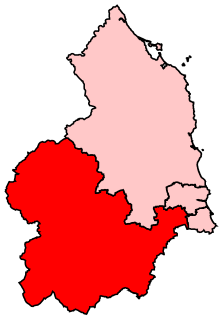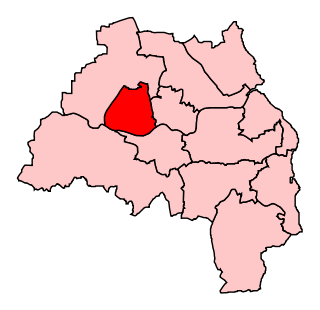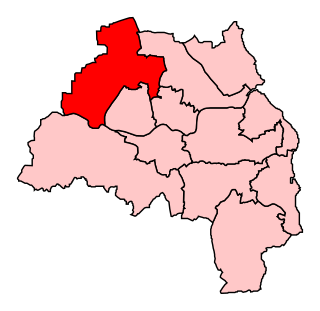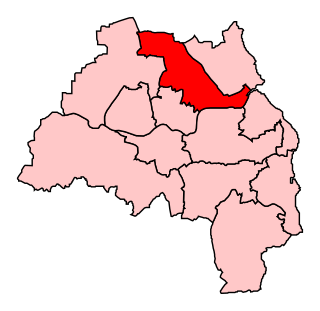
Tyne and Wear is a metropolitan county in North East England, situated around the mouths of the rivers Tyne and Wear. It was created in 1974, by the Local Government Act 1972, along with five metropolitan boroughs of Gateshead, Newcastle upon Tyne, Sunderland, North Tyneside and South Tyneside. It is bordered by Northumberland to the north and Durham to the south; the county boundary was formerly split between these counties with the border as the River Tyne.

North Tyneside is a metropolitan borough in the metropolitan county of Tyne and Wear, England. It forms part of the greater Tyneside conurbation. North Tyneside Council is headquartered at Cobalt Park, Wallsend.

Hexham is a constituency in Northumberland represented in the House of Commons of the UK Parliament since 2010 by Guy Opperman, a Conservative. As with all constituencies, the constituency elects one Member of Parliament (MP) by the first past the post system of election at least every five years.

Newcastle upon Tyne Central is a constituency represented in the House of Commons of the UK Parliament since 2010 by Chi Onwurah of the Labour Party. As with all constituencies, the constituency elects one Member of Parliament (MP) by the first past the post system of election at least every five years.

Newcastle upon Tyne East and Wallsend was, from 1997 until 2010, a constituency represented in the House of Commons of the Parliament of the United Kingdom. It elected one Member of Parliament (MP) by the first past the post system of election.

Newcastle upon Tyne North is a constituency represented in the House of Commons of the UK Parliament since 2010 by Catherine McKinnell of the Labour Party.

Tynemouth is a constituency in Tyne and Wear represented in the House of Commons of the UK Parliament since 1997 by Sir Alan Campbell, a member of the Labour Party.

North Tyneside is a constituency represented in the House of Commons of the UK Parliament since 2010 by Mary Glindon of the Labour Party.

Wansbeck is a constituency represented in the House of Commons of the UK Parliament since 2010 by Ian Lavery, a member of the Labour Party.

Berwick-upon-Tweed is a parliamentary constituency in Northumberland represented in the House of Commons of the UK Parliament since 2015 by Anne-Marie Trevelyan, a Conservative.

Newcastle upon Tyne East is a constituency represented in the House of Commons of the UK Parliament by Nick Brown of the Labour Party. Brown has held the seat since its recreation in 2010.
Altrincham was a county constituency of the House of Commons of the Parliament of the United Kingdom from 1885 to 1945. It elected one Member of Parliament (MP) by the first past the post system of election.

Crewe was a constituency of the House of Commons of the Parliament of the United Kingdom from 1885 to 1983. It elected one Member of Parliament (MP) by the first past the post system of election.
Newcastle upon Tyne West was a parliamentary constituency in the city of Newcastle upon Tyne from 1918 to 1983 which returned one Member of Parliament (MP) to the House of Commons of the Parliament of the United Kingdom.
Wallsend was a parliamentary constituency centred on Wallsend, a town on the north bank of the River Tyne in North Tyneside.
Newcastle-upon-Tyne was a parliamentary borough in the county of Northumberland of the House of Commons of England from 1283 to 1706, then of the House of Commons of Great Britain from 1707 to 1800 and of the House of Commons of the United Kingdom from 1801 to 1918. It returned two Members of Parliament (MPs), elected by the bloc vote system.
Tynemouth and North Shields was a parliamentary borough constituency represented in the House of Commons of the Parliament of the United Kingdom between 1832 and 1885. It elected one Member of Parliament (MP) by the first-past-the-post system of election.
The ceremonial county of Hertfordshire has returned 11 MPs to the UK Parliament since 1997.
The county of Northumberland has returned four MPs to the UK Parliament since 1983. Under the Local Government Act 1972, which came into effect on 1 April 1974, the boundaries of the historic/administrative county were significantly altered with the south-east of the county, comprising more than half the electorate, being transferred to the new metropolitan county of Tyne and Wear. These changes were reflected in the following redistribution of parliamentary seats which did not come into effect until the 1983 general election, resulting in a reduction in the county's representation from 10 to 4 MPs.














